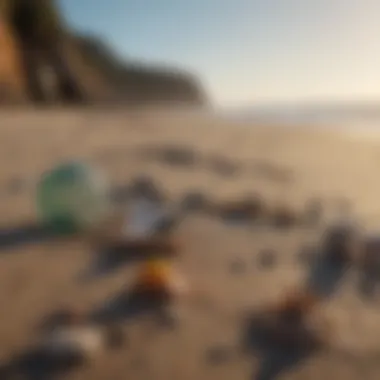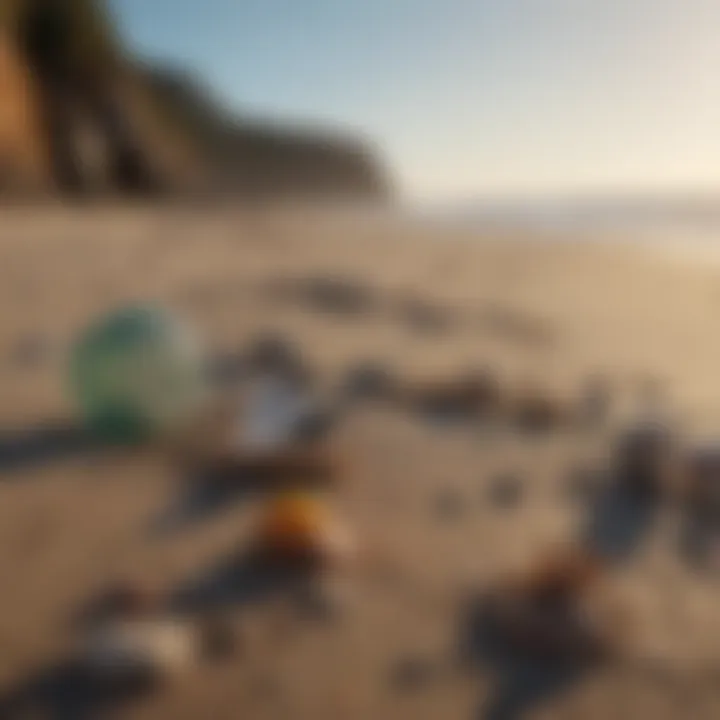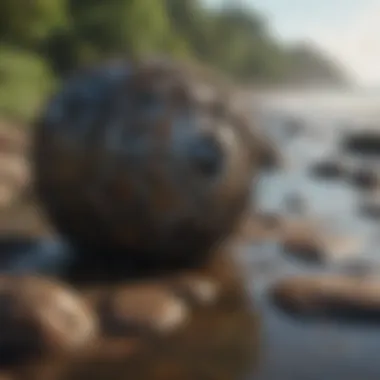Understanding Coastal Waste: Origins and Solutions


Overview of the Topic
Coastal waste is an intricate issue that affects every corner of our planet's shorelines. Globalization, urbanization, and rising consumption patterns have given birth to a staggering amount of waste piling up along our coastal regions. This waste is not just an eyesore; it wreaks havoc on marine ecosystems, compromises human health, and disrupts local economies reliant on fishing and tourism.
The significance of understanding coastal waste cannot be understated. Coastal communities often serve as the frontline in the battle against pollution, making them critical players in conservation and sustainability efforts. Moreover, these areas are rich in biodiversity, hosting unique species and habitats that are vulnerable to the impact of waste. Thus, examining the origins and consequences of coastal waste is vital for fostering a deeper awareness and motivating proactive steps toward managing this pressing global issue.
Current Status and Challenges
Today, the state of coastal waste remains alarming. Estimates suggest that millions of tons of plastic enter oceans each year. A substantial portion of this waste finds its way into coastal waters, where it can remain for centuries. Current challenges surrounding coastal waste are manifold:
- Plastic Pollution: Single-use plastics dominate the waste spectrum, being notoriously difficult to recycle and often ending up in oceans.
- Economic Strain: Local economies suffer as tourism declines due to pollution, while fishing yields diminish amid declining fish populations affected by waste.
- Biodiversity Threats: Marine life, including seabirds and fish, are severely impacted. It is not uncommon for animals to ingest plastic or become entangled, often leading to tragic outcomes.
Addressing these challenges requires a concerted effort at multiple levels—community, national, and international.
Sustainable Solutions
In light of the challenges posed by coastal waste, various sustainable practices have emerged. Communities are increasingly adopting innovative waste management strategies to mitigate the effects of pollution. Some notable solutions include:
- Community Clean-Up Initiatives: Local volunteers and organizations come together for beach clean-up projects, removing trash and raising awareness.
- Recycling and Upcycling Programs: Some coastal towns have begun to implement effective waste separation and recycling programs, encouraging residents to actively participate in reducing waste.
- Policy Changes: Legislative evaluations aimed at reducing plastic production and encouraging sustainable alternatives are gradually gaining traction.
Examples of successful case studies can be found in destinations that have turned the tide on coastal waste, where partnerships between local governments and NGOs have led to significant reductions in waste footprint.
Impact and Importance
The impact of coastal waste extends far beyond environmental degradation. It carries profound implications for human communities as well. The repercussions of neglecting waste management can be severe:
- Ecosystem Disruption: The long-term health of marine environments is at stake. Waste can change sediment structures, pollute water, and disrupt food chains.
- Economic Viability: As coastal ecosystems falter, industries dependent on marine resources face uncertain futures, which puts livelihoods at risk.
- Intergenerational Responsibility: The choices we make today will dictate the future state of our oceans and coastlines. The very resources that future generations will rely on are now in jeopardy.
Quote: "The ocean is a shared resource, and its health reflects our choices, both individually and collectively. It is our responsibility to ensure its future for upcoming generations."
Preface to Coastal Waste
The world’s coastlines are under siege from a relentless tide of waste, making the study and understanding of coastal waste not only necessary but urgent. Coastal areas are vital ecosystems; they serve as habitats for diverse marine life, act as buffers against storms, and are often the cornerstone of local economies that depend on tourism and fisheries. Yet, these regions are increasingly burdened by pollution and waste, which can lead to severe ecological consequences.
Importance of the Topic
Understanding coastal waste is crucial for various reasons. It not only sheds light on the health of marine ecosystems but also illuminates the socioeconomic impact on communities that rely on these areas for their livelihoods. When waste accumulates along coastlines, it affects both human and marine life, endangering species and disrupting local economies. Moreover, raising awareness around the issue can catalyze community action and empower individuals to take more sustainable steps.
Here are some key elements to consider:
- The intricate connection between coastal waste and marine biodiversity.
- How local communities are directly impacted by waste, economically and health-wise.
- The influence of tourism and recreational activities on coastal waste policies.
In exploring this topic, the article aims to deliver a detailed picture of the challenges posed by coastal waste. It will dive into its origins, how it impacts marine life, and the strategies in place to combat these issues. As we unravel these threads, a more profound understanding will emerge, paving the way for innovative solutions that honor both our environment and the communities that depend on it.
Defining Coastal Waste
Coastal waste encompasses a range of materials that accumulate in or along the shoreline. This could include plastic bottles, fishing gear, sewage, and chemicals, among other debris. As simple as it might sound, the definition extends well beyond just litter; it represents a myriad of discarded items that not only detract from the natural beauty of coastlines but bring with them a multitude of ecological challenges.
Coastal waste can be classified into two main categories: macro and micro waste. Macro waste consists of larger items like discarded containers and nets, while micro waste is often more insidious, comprising tiny plastic particles that result from the degradation of larger pieces or from products that are purposefully designed to be small, such as microbeads in facial scrubs. Both types pose significant threats to marine life and human health, making it imperative to grasp their impact.
Historical Context
The problem of coastal waste is not a recent phenomenon. It has evolved alongside industrialization and growing consumerism. Historically, waste disposal methods were unregulated. Many coastal regions became dumping grounds for various forms of waste, reflecting a collective disregard for the long-term health of marine environments.
From the aftermath of World War II, the view of coasts as limitless dumping sites candidly highlighted society's lack of consideration for the ocean’s role in global health. As economies grew, so did the waste; with rapid urbanization and the convenience of single-use products, plastic pollution burgeoned.
In the late 20th century, awareness began to rise about the plight of the oceans—a movement sparked by tales like those of the Great Pacific Garbage Patch. Studies revealed the stark reality that our waste not only floats on the surface but also permeates the depths, indicating just how pervasive the issue is. This shift in perception has led to international dialogues, agreements, and an increased push for sustainable waste management practices, laying the groundwork for more proactive approaches to tackling coastal waste.
"The ocean is the world's largest ecosystem, and yet we treat it as a limitless resource, not realizing the consequences that our waste has on it."


Understanding where we’ve been helps to frame the ongoing struggles and solutions being implemented today. As we progress through the article, we’ll delve deeper into the sources of this waste, its environmental impacts, and the socio-economic ramifications that come with the territory. By connecting historical precedence and current events, we can better appreciate the gravity of the situation and the urgent need for cohesive action.
Sources of Coastal Waste
Understanding the sources of coastal waste is crucial for devising effective management strategies. By identifying where waste originates, stakeholders can target interventions to mitigate its impact. Coastal waste not only threatens marine ecosystems but also poses socioeconomic challenges to communities dependent on these resources. In addition, the awareness of waste sources helps prioritize cleanup efforts and influences policy decisions.
Land-Based Sources
Land-based sources of waste are among the most significant contributors to coastal pollution. Urban runoff, industrial discharges, and improper waste disposal play critical roles in contaminating waterways. When it rains, water flows over streets and landscapes, picking up litter, chemicals, and nutrients that eventually find their way to the coast.
- Urban Runoff: Stormwater collects debris such as plastic, metals, and organic waste. Cities with insufficient drainage infrastructure exacerbate this issue. As a result, large quantities of trash wash into oceans during heavy rains.
- Industrial Discharges: Factories and plants often discharge harmful chemicals, directly impacting aquatic life and local communities. For instance, wastewater often contains heavy metals and toxins that accumulate in the food chain.
- Improper Waste Disposal: When individuals and businesses improperly dispose of trash, it can easily reach coastal areas. An example includes disposing of household waste in drains, leading to clogged systems and overflow onto beaches.
Marine Activities and Their Impact
Marine activities contribute another significant source of coastal waste. These operations not only produce physical waste but can also lead to ecological imbalances. Fishing, shipping, and recreational boating demand attention when discussing waste sources.
- Fishing Practices: Fishing gear, such as nets and lines, can be accidentally or intentionally discarded into the ocean, creating hazards for marine life. These ghost nets entangle fish and other creatures, which consume their energy and ultimately die.
- Shipping Industry: The shipping industry generates vast amounts of waste, including ballast discharge and cargo residue. When ballast water is released into coastal areas, it may introduce invasive species, which can wreak havoc on local ecosystems.
- Recreational Boating: With the popularity of boating and water sports, waste produced by recreational vehicles also adds to coastal pollution. Wastewater from boats can contribute to nutrient enrichment in coastal waters, leading to harmful algal blooms.
Tourism and Recreational Waste
Tourism has a dual impact on coastal areas. While it brings economic benefits, it can also significantly increase waste generation, particularly during peak seasons. Beachgoers and tourists produce litter and debris that can accumulate quickly if not managed properly.
- Littering by Visitors: Many tourists may not be fully aware of the environmental impact their waste has on coastal ecosystems. During busy seasons, items such as food wrappers, plastic bottles, and cigarette butts often litter sandy beaches.
- Impact on Local Wildlife: Increased human activity can disturb local wildlife, leading to unintentional consequences. For example, nesting sea turtles may be affected by trash obstructing their nesting sites or artificial light disrupting their natural behavior.
- Infrastructure Challenges: In tourist-heavy locales, the infrastructure for waste management can become overburdened. If local resources cannot keep pace with the growing volume of waste, it can exacerbate coastal pollution issues.
The majority of waste found in coastal regions originates from land-based sources, and addressing these is vital for sustainable marine environments.
Understanding these sources is not just about pinpointing blame but advancing toward practical solutions. By addressing these issues head-on, we pave the way for cleaner coastlines and healthier marine ecosystems.
Environmental Impacts of Coastal Waste
Coastal waste, largely stemming from human activity, poses significant threats to marine environments. This section elucidates the consequences of such waste accumulation, specifically focusing on marine life, ecosystem integrity, and human health concerns. Understanding these impacts is paramount not just for environmentalists but for anyone who cherishes the ocean and its resources.
Impact on Marine Life
Effects on Biodiversity
Biodiversity in marine ecosystems is like a well-tuned orchestra, where each species plays its unique part in maintaining balance. However, coastal waste introduces a discordant note, jeopardizing this harmony. For instance, plastic debris can smother coral reefs, denying them sunlight needed for photosynthesis. As species begin to dwindle, some, like certain species of fish, might not find their usual spawning grounds.
These effects ripple through ecosystems, threatening the very fabric of life in the ocean. The loss of biodiversity diminishes nature's resilience, leaving ecosystems more vulnerable to climate change and other stressors. It’s not hard to see why preserving biodiversity is a focal point for conservationists; it’s about protecting the delicate balance of life itself.
Marine Species at Risk
Some species are particularly vulnerable to the predations of coastal waste. Sea turtles, for example, often mistake plastic bags for jellyfish, a primary food source. Ingesting such waste can block their intestinal tracts, leading to starvation or death.
Highlighting marine species at risk is not merely a matter of statistics. It's about the ethical implications of our choices. Iconic species like dolphins, which serve as indicators of ocean health, progressively face threats from accumulated waste. Their dwindling numbers can serve as a wake-up call for humanity, urging proactive measures to tackle coastal waste issues.
Ecosystem Disruption
Disruption of Food Chains
Coastal waste disrupts food chains, often in insidious ways. For instance, small fish that eat microplastics may find their growth stunted or suffer from toxic effects. When these fish form the diet of larger predators, including commercially important species, the ramifications can destabilize entire food webs.
The ripple effects of such disruptions underscore the interconnectedness of life in the sea. Every served plate of seafood we enjoy can be traced back to these intricate relationships. Recognizing this highlights the need for stringent waste management practices that can alleviate these disruptions.
Habitat Degradation
Furthermore, coastal waste contributes to habitat degradation. Wetlands, salt marshes, and mangroves serve as crucial habitats for countless marine species. Yet, pollutants and waste can choke these ecosystems, inhibiting their natural functions like filtering water and providing shelter. This degradation not only affects wildlife but also diminishes the protective barriers these habitats offer against storms and rising sea levels.
In the end, acknowledging habitat degradation is key to formulating successful restoration strategies. Understanding what is lost gives urgency to conservation efforts, reminding us that healthy habitats bolster both marine life and community resiliency.
Human Health Concerns


Toxicity Issues
Coastal waste isn’t just a marine issue; it also has serious implications for human health. Chemicals from plastic and other waste materials can leach into the food chain, affecting seafood safety. When humans consume contaminated fish, they may inadvertently ingest toxins that have serious long-term health effects.
Addressing toxicity is crucial for fostering a healthy populace. Awareness campaigns that inform consumers of the risks associated with seafood from polluted regions could be a beneficial approach. Shining a light on these issues promotes accountability and pushes authorities to take action against pollution.
Impacts on Local Communities
Local communities that rely on coastal resources face direct threats from coastal waste. Fishing industries may see dwindling catch sizes, impacting livelihoods profoundly. Moreover, the aesthetic and recreational value of these areas diminishes when littered with waste, driving tourists away and stunting local economies.
The repercussions echo throughout these communities, creating an atmosphere of neglect and despair. Creating a sustainable model that values clean coastal environments can inspire action. By understanding these impacts, we can encourage community engagement aimed at coastal conservation and recovery.
Socioeconomic Dimensions of Coastal Waste
Understanding the socioeconomic dimensions of coastal waste is key, especially when exploring the broader implications of pollution on communities and economies. Waste accumulation along coastlines isn't simply an environmental issue; it intertwines deeply with social structures and economic viability. This section dives into the multifaceted impacts coastal waste has on our societies.
Economic Costs of Cleanup
Cleaning up coastal waste is no small feat. It demands a significant allocation of resources, both financial and human. Municipalities and local governments often find themselves in a catch-22 situation: they need to maintain clean coastlines to attract tourism, yet the cost of cleanup can be staggering.
For instance, in 2021, a report indicated that beach cleanups in California alone reached costs exceeding $60 million annually. These expenses include labor, equipment, waste disposal, and public awareness campaigns. Each year, cities must prioritize their budgets, often leading to tough decisions between community welfare and environmental upkeep.
Moreover, the economic impact of not addressing coastal waste can be far-reaching. Without effective cleanup efforts, beaches may become unattractive to visitors, causing a decline in tourism revenue. In coastal regions relying heavily on tourism, this can mean job losses in service sectors like hospitality and entertainment, spiraling into broader economic downturns.
Impact on Local Economies
The effects of coastal waste aren't limited to just cleanup costs; they stretch into the very fabric of local economies. Many towns and cities situated along coastlines depend on vibrant marine-based industries. An increase in coastal pollution can jeopardize fishing industries, threatening both the livelihoods of local fishers and the supply chain for seafood lovers.
- Fisheries Decline: Over time, pollutants can cause a decline in fish populations or even lead to fish being unfit for consumption. This can drastically reduce local catch, harming not just the economy but the culture of fishing communities.
- Tourism Revenue Loss: As noted earlier, tourism is a substantial contributor to coastal economies. Dirty beaches can deter visitors, directly affecting hotels, restaurants, and activities that thrive off tourist spending. For example, towns like Destin in Florida have seen fluctuations in tourist numbers tied to shoreline cleanliness, showcasing the direct correlation between waste management and economic health.
- Increased Cost of Living: As local economies struggle due to reductions in revenue, towns may face increased costs for basic services. All this can lead to the burden being placed on local residents, altering the dynamics of the community.
Global Perspectives on Coastal Waste Management
Coastal waste management is not just a local or regional issue; it transcends borders and calls for a collective response from nations around the globe. This section highlights the importance of adopting a global perspective on coastal waste management, focusing on various elements such as shared challenges, successful strategies, and international collaboration.
Understanding how different countries tackle the problem allows for the exchange of ideas and practices that could be beneficial everywhere. Furthermore, looking at global trends provides insights into potentially effective methodologies that can be adapted according to local conditions. This article will discuss case studies that showcase how various regions have addressed coastal waste, highlighting both successes and failures, as well as the international policies that aim to mitigate this pressing issue.
Case Studies from Around the World
Successful Mitigation Strategies
Many nations have developed successful mitigation strategies that serve as blueprints for others grappling with coastal waste. For example, Japan's rigorous waste sorting system stands out due to its community engagement and strict regulations. Residents are educated on waste categories, and the system promotes recycling and reusing over discarding.
One significant characteristic of Japan's approach is its emphasis on public education and outreach. By instilling a sense of responsibility within communities, the initiative has cultivated a culture of sustainability. This strategy is beneficial as it empowers individuals to take ownership, leading to tangible results in reducing waste.
However, while the educational aspect is a strong point, the political framework backing it can also be seen as both an advantage and a challenge. The strict regulations can create tensions in communities with less willingness to comply.
Lessons Learned
Examining past failures and successes has proven essential in shaping current practices. For instance, the Philippines faced significant challenges in addressing coastal waste until stakeholders began to recognize the importance of community involvement. Overreliance on top-down approaches had led to disillusionment among the public and ineffective outcomes.
The key characteristic of these lessons learned is their focus on community-led initiatives. Empowering local communities to take action has shown remarkable results, such as in the case of the coastal clean-up drives in Manila Bay. This grassroots approach has fostered a stronger sense of stewardship for local environments.
Unique to these lessons is the understanding that change doesn’t happen overnight; it requires patience and commitment from communities. However, these community-driven efforts can sometimes be met with obstacles such as funding limitations and lack of infrastructure. Thus, while the benefits are clear, careful consideration must be given to maintaining momentum once initiatives are launched.
International Policies and Agreements
Numerous international policies have been established to address coastal waste management. Agreements like the Paris Agreement have implications even for coastal ecosystems and underline the necessity for global cooperation. Nations recognize that unchecked waste can lead to broader environmental degradation, affecting climate, wildlife, and even human health in various regions.
These policies reinforce the idea that waste management is not a solitary venture. Instead, it encompasses a web of influences that necessitate collective action across borders.
"When we approach coastal waste management with an open mind and willingness to adapt strategies from around the world, the possibilities for improvement are boundless."


Innovative Solutions for Reducing Coastal Waste
Addressing the challenge of coastal waste is not just about cleaning up after the fact; it's about implementing innovative solutions that target the root causes of this pressing issue. Coastal regions are some of the most vibrant ecosystems on the planet, critical for biodiversity and human activity alike. Therefore, putting our minds together to find effective solutions is fundamentally important for sustainable management.
When we talk about innovative solutions, it encompasses both cutting-edge technology and community-driven efforts that can create lasting impacts. This multifaceted approach helps not only to reduce the amount of waste finding its way into our coastlines but also promotes a culture of stewardship that can empower local communities.
Technological Innovations
In the realm of technology, there are many dazzling examples that have taken the field of waste management by storm. For instance, the use of drones has become increasingly popular for identifying coastal pollution hotspots. These flying devices allow environmentalists to survey large areas within a short time and gather data that can inform cleanup efforts. Improvements in sensor technology also enable real-time monitoring of pollutants, providing a more accurate understanding of the health of coastal environments.
Another interesting development is the rise of biodegradable materials. Companies are now focusing on creating alternatives to traditional plastics that would break down harmlessly instead of persisting in the environment for centuries. Products made from organic compounds can reduce the volume of waste that contributes to coastal pollution significantly. The research into ocean-cleaning drones, similar to those used in combating oil spills, is also noteworthy. These unmanned vessels have the capability to skim off floating debris and contaminants from the ocean surface directly, enhancing the efficiency of cleanup missions.
Additionally, there are advancements in waste conversion technologies—like pyrolysis—that turn plastic waste into fuel. This not only cuts down on the waste itself but also transforms it into an energy resource, proving that innovation can yield economic benefits as well.
"Technological innovations can transform the way we approach coastal waste management, creating scalable solutions that address immediate issues while paving the way for a cleaner future."
Community Involvement and Grassroots Movements
While technology plays a crucial role in tackling coastal waste, we must recognize the importance of community involvement. Grassroots movements often stem from local residents who are passionate about preserving their environment. These movements can mobilize efforts to clean up coastlines and protect marine habitats.
Local initiatives, whether organized beach cleanups or awareness campaigns, can create ripples of change in societal attitudes towards waste disposal. Education is at the heart of these efforts—when communities understand the consequences of coastal waste, they are more likely to take action. For example, schools collaborating with conservation organizations can promote curriculum focused on marine biology and ecology, fostering a sense of responsibility amongst younger generations.
Moreover, social media platforms such as Facebook and Reddit can amplify voices advocating for coastal conservation. People can share their experiences, discuss challenges, and celebrate victories, thereby building a community of like-minded individuals committed to making a difference.
Collaboration with local businesses can further enhance these initiatives—encouraging them to sponsor events, donate resources, or adopt more sustainable practices—that’s where real change begins.
In essence, the future of managing coastal waste rests on a partnership between technology and localized efforts, creating a balanced approach that not only addresses immediate problems but also nurtures a culture of awareness and responsibility.
Future of Coastal Waste Management
The future of coastal waste management is a pressing subject that encompasses various elements critical to sustainable environmental practices and community resilience. As coastal regions continue to grapple with the impacts of waste accumulation, addressing this issue effectively is essential for ensuring the health of marine ecosystems, protecting biodiversity, and supporting local economies reliant on these natural resources.
It’s vital to focus on innovative and adaptable strategies that can meet the ever-evolving challenges of waste management. This means not just implementing advanced technologies or policies, but also fostering community engagement and collaboration. Strong community involvement can lead to better stewardship of coastal areas, as local knowledge and practices often are key to the successful management of waste.
Moreover, the integration of sustainable practices into industries that impact coastal environments—such as fishing, tourism, and shipping—can significantly reduce the generation of waste. As sectors become more aware of their footprints, the adoption of circular economy principles may also help minimize waste and improve resource efficiency.
Trends and Predictions
The landscape of coastal waste management is rapidly changing. Several trends are emerging that carry significant implications for how we approach this issue moving forward.
- Increased Use of Technology
Advances in technology are catalyzing better waste tracking, monitoring, and processing. Drones and satellite imagery are being employed to survey waste distribution and assess environmental impacts from a broader perspective, which has never been done before in coastal areas. - Stronger Policy Frameworks
National and international policies are evolving to address the complexities of waste management. Expect regulations to become more stringent and aligned with environmental sustainability goals, compelling industries to adopt eco-friendly practices. - Rise of Community Initiatives
Communities are stepping up their game. Grassroots movements for cleaning up coastlines and raising awareness about waste are becoming more organized and influential. These initiatives not only engage the public but also encourage legislative action. - Focus on Biodegradable Materials
As awareness grows around the detrimental effects of plastics, there’s a noticeable shift towards biodegradable alternatives. Industries and consumers alike are emphasizing products that have minimal environmental impact. - Educational Programs Expansion
Educational initiatives are integrating waste management into school curriculums. This trend ensures that future generations are not only aware of but also actively contribute to solutions surrounding coastal waste.
Role of Education and Awareness
Education and awareness are cornerstones of effective coastal waste management. Without a well-informed public, efforts to mitigate waste will struggle to gain traction. Here are some key roles education plays in improving the situation:
- Dissemination of Knowledge: Informing individuals about the sources and impacts of coastal waste equips them with understanding the relevance of their behaviors.
- Behavior Change: Education programs can inspire changes in consumption habits and lead individuals to make more environmentally responsible choices. This could even include a shift in tourism practices, where visitors prioritize eco-friendly options.
- Empowerment and Engagement: Knowledge fosters empowerment, enabling communities to actively participate in initiatives aimed at reducing waste. When people feel equipped with information, they are more likely to contribute to cleanup efforts or advocate for stronger policies.
"The cornerstone of successful coastal waste management lies in an informed community dedicated to preserving their natural resources."
- Collaboration with Local Governments: Educational programs often collaborate with local governments to implement projects that rise from the community’s needs, ensuring that solutions are tailored and effective.
As we look to the future, the interconnection of these elements will shape how we approach and resolve the ongoing coastal waste crisis. Engaging rising generations through education ensures a more sustainable and environmentally-conscious society.
End and Call to Action
As we dive into the murky waters of coastal waste, the realities become glaringly clear. This issue is not just a concern for conservationists or environmentalists; it affects local economies, marine biodiversity, and human health. We’ve uncovered the various sources of waste, its environmental toll, and socioeconomic implications. Yet, knowledge is only the first step.
The crux of addressing the ongoing problem of coastal waste lies in action. Now is the time to rally communities, policy makers, and everyday individuals to tackle this issue head-on. Here are some pivotal points to consider in your call to action:
- Community Engagement: Local initiatives like beach clean-ups and awareness campaigns are vital. Residents should not only be informed but also empowered to take part in preserving their environment.
- Policy Advocacy: It’s essential to support policies that regulate waste management and promote sustainable practices. Engage with local governments to express the need for stricter regulations on waste disposal.
- Education: Schools and community groups should prioritize educating young people about coastal waste, allowing them to grasp its implications on their future. Knowledge instills a sense of responsibility.
- Partnerships: Collaboration between governments, NGOs, and private sectors can leverage resources and ideas, providing innovative solutions to old problems.
"Awareness without action is just a dream. Let’s make awareness the first step towards action."
Effective solutions for managing coastal waste often stem from innovative technological approaches as well as grassroots movements. By supporting these initiatives, individuals can contribute to creating a systemic change that effectively addresses waste at its core.
The future of our coastlines hangs in the balance. Are we going to be passive observers as they deteriorate under the weight of waste, or will we rise up and take action? Each small effort counts, and collectively can lead to significant restoration. Let’s make waves in the fight against coastal waste.



